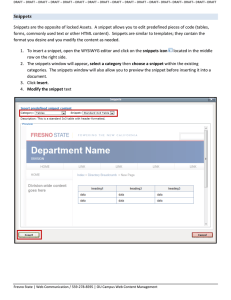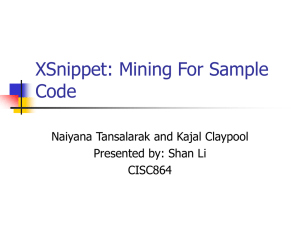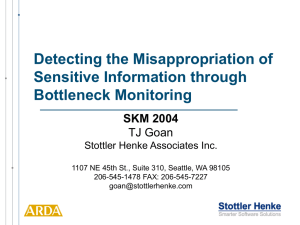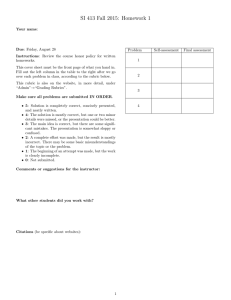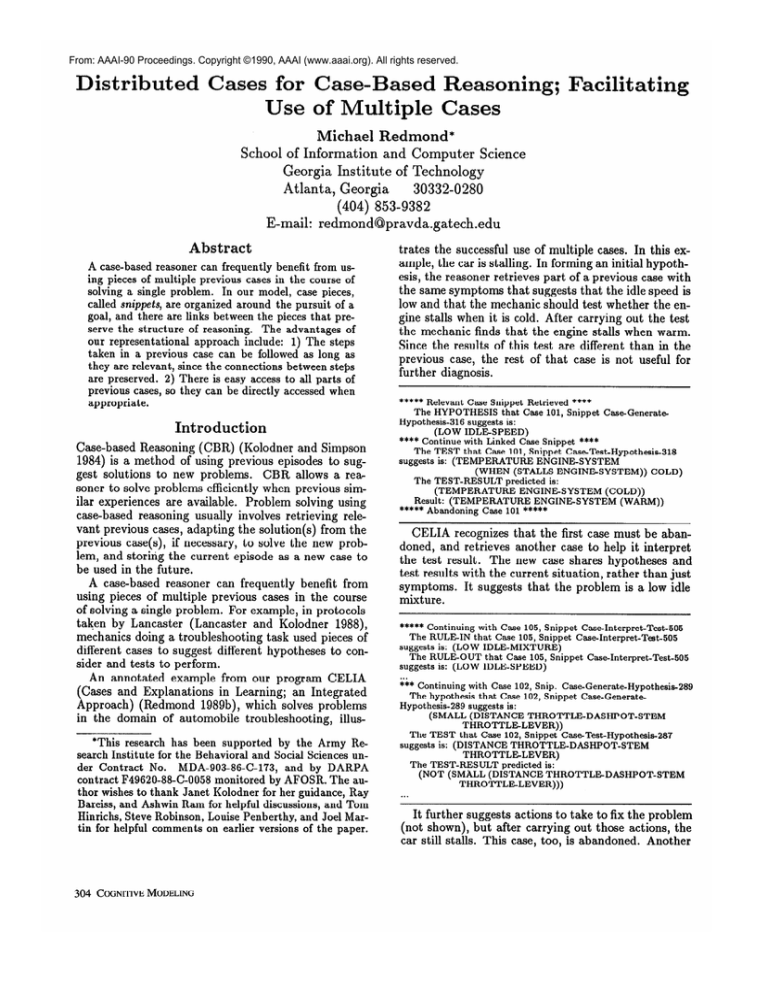
From: AAAI-90 Proceedings. Copyright ©1990, AAAI (www.aaai.org). All rights reserved.
Distributed
Cases for Case-Based
Use of Multiple
Reasoning;
Cases
Facilitating
Michael Redmond*
School of Information and Computer Science
Georgia Institute of Technology
Atlanta, Georgia
30332-0280
(404) 853-9382
E-mail: redmond@pravda.gatech.edu
Abstract
A case-based reasoner can frequently benefit from using pieces of multiple previous cases in the course of
solving a single problem. In our model, case pieces,
called snippets, are organized around the pursuit of a
goal, and there are links between the pieces that preserve the structure of reasoning. The advantages of
our representational approach include: 1) The steps
taken in a previous case can be followed as long as
they are relevant, since the connections between steps
are preserved. 2) There is easy access to all parts of
previous cases, so they can be directly accessed when
appropriate.
Introduction
Case-based Reasoning (CBR) (Kolodner and Simpson
1984) is a method of using previous episodes to suggest solutions to new problems. CBR allows a rea
saner to solve problems efficiently when previous similar experiences are available. Problem solving using
case-based reasoning usually involves retrieving relevant previous cases, adapting the solution(s) from the
previous case(s), if necessary, to solve the new problem, and storing the current episode as a new case to
be used in the future.
A case-based reasoner can frequently benefit from
using pieces of multiple previous cases in the course
of solving a single problem. For example, in protocols
taken by Lancaster (Lancaster and Kolodner 1988),
mechanics doing a troubleshooting task used pieces of
different cases to suggest different hypotheses to consider and tests to perform.
An annotated example from our program CELIA
(Cases and Explanations in Learning; an Integrated
Approach) (Redmond 1989b), which solves problems
in the domain of automobile troubleshooting, illus*This research has been supported by the Army Research Institute for the Behavioral and Social Sciences under Contract No. MDA-903-86-C-173,
and by DARPA
contract F49620-88-C-0058
monitored by AFOSR. The author wishes to thank Janet Kolodner for her guidance, Ray
Bareiss, and Ashwin Ram for helpful discussions, and Tom
Hinrichs, Steve Robinson, Louise Penberthy, and Joel Martin for helpful comments on earlier versions of the paper.
304 C~GNI~VEMODELING
trates the successful use of multiple cases. In this example, the car is stalling. In forming an initial hypothesis, the reasoner retrieves part of a previous case with
the same symptoms that suggests that the idle speed is
low and that the mechanic should test whether the engine stalls when it is cold. After carrying out the test
the mechanic finds that the engine stalls when warm.
Since the results of this test are different than in the
previous case, the rest of that case is not useful for
further diagnosis.
***** Relevant Case Snippet Retrieved ****
The HYPOTHESIS that Case 101, Snippet Case-GenerateHypothesis-316 suggests is:
(LOW IDLESPEED)
**** Continue with Linked Case Snippet ****
The TEST that Case 101, Snippet CaseTest-Hypothesis-318
suggests is: (TEMPERATURE
ENGINE-SYSTEM
(WHEN (STALLS ENGINE-SYSTEM))
COLD)
The TEST-RESULT predicted is:
(TEMPERATURE
ENGINE-SYSTEM
(COLD))
Result: (TEMPERATURE
ENGINE-SYSTEM
(WARM))
***** Abandoning Case 101 *****
CELIA recognizes that the first case must be abandoned, and retrieves another case to help it interpret
the test result. The new case shares hypotheses and
test results with the current situation, rather than just
symptoms. It suggests that the problem is a low idle
mixture.
***** Continuing with Case 105, Snippet Case-Interpret-Test-505
The RULE-IN-that Case 105, Snippet Case-Interpret-Test-505
suggests is: (LOW IDLE-MIXTURE)
The RULE-OUT that Case 105, Snippet Case-Interpret-Test-505
suggests is: (LOW IDLE-SPEED)
*** Continuing with Case 102, Snip. Case-Generate-Hypothesis-289
The hypothesis that Case 102, Snippet Case-GenerateHypothesis-289 suggests is:
(SMALL (DISTANCE THROTTLE-DASHPOT-STEM
THROTTLE-LEVER))
The TEST that Case 102, Snippet CaseTest-Hypothesis-287
suggests is: (DISTANCE THROTTLE-DASHPOT-STEM
THROTTLELEVER)
The TEST-RESULT predicted is:
(NOT(SMALL
(DISTAIWETHFL~TTLEDASHP~T-STEM
THROTTLELEVER)))
It further suggests actions to take to fix the problem
(not shown), but after carrying out those actions, the
car still stalls. This case, too, is abandoned. Another
case is retrieved that suggests a new hypothesis: the
throttle dashpot is out of place. It suggests checking
if the distance between the throttle dashpot and the
throttle lever is too short. This hypothesis proves to
be correct, the fix it suggests is carried out and the
problem is fixed.
The process we are describing is one of using pieces
We have obof several cases to solve a problem.
served this happening in automobile troubleshooting
(Lancaster and Kolodner 1988)) medical diagnosis, and
meal planning (Hinrichs 1988). We suspect that it is
common to any problem solving task that is solved
by addressing subgoals individually. It is especl’ally
evident when planning and execution are interleaved,
where the results of execution are not always as predicted. In order for several cases to be used efficiently
in combination with each other, several issues must be
addressed.
How to retrieve a case when some part of it could
prove useful.
e How to find and isolate the parts of the previous
case that will be useful in the current context.
o How to form generalizations to reflect commonalities
in parts of the problem solving experiences.
l
In this paper we discuss a case representation that
enables effective combination of multiple cases by making each part of a case directly accessible, while retaining the links between the parts.
Case Representation
When more than one case is used to solve a problem,
frequently only parts of each case will be useful in the
synthesis. These parts might be buried within an extended sequence of actions serving many goals. For
example, when a reasoner is trying to find a test for a
particular hypothesis, the relevant test part of a case
is all he needs to focus on. The actions taken and
the other hypotheses are not important at that time.
Cases must therefore be represented such that their
parts can be efficiently accessed.
Traditionally, cases used by case-based reasoners
have been treated as monolithic entities l. That is,
an episode is stored as a single instantiation of a single
knowledge structure. Aspects of a case are specified
as slots in the representation. Although many of these
representations have structured representation within
slots and reasoning can be applied to parts of a case,
indexing, in general, retrieves the case as a whole.
Treating a situation as a monolithic case and embedding everything in it creates problems for using parts
of multiple cases to solve one problem:
e Retrieval of the parts of the case that can be helpful in a given situation has to be a two step process. First, the appropriate case must be accessed,
then the currently useful parts hidden inside the case
must be found. It can take a lot of effort to find them
within the case, even given the right indices to the
‘See Related Work section for some exceptions.
situation. A one step process allowing direct access
to the useful parts of cases would be more efficient.
e Monolithic cases contain too much information for a
system to be able to do useful generalization. Since
cases have many parts, some of which should be
generalized with parts of other cases, but others of
which are unique, generalization of commonalities
may be delayed.
In order for the appropriate part of a case to be accessed when it can be useful, in the middle of problem
solving, it is advantageous to divide cases into pieces.
In our model,
Cases are stored in pieces, or snippets (Kolodner
1988). This allows the reasoner to use small fragments of cases in its reasoning rather than having to
wade through large monolithic cases.
Each snippet is organized around one particular
goal, and contains information pertaining to the pursuit of that goal.
Each snippet contains the current problem solving
context at the time the goal was initiated, including
the initial problem description and results of actions
taken so far.
There are links between the snippets that preserve
the structure of the diagnosis. Each snippet is linked
to the snippet for the goal that suggested it and to
the snippets for the goals it suggests.
Content of Snippets
Each snippet can be thought of as a scene of the larger
episode. A snippet has three main types of information. First, is the problem solving context at the time
of the snippet’s occurrence. Second is information related to the goal that the snippet is centered around.
Last is information linking the snippet to other related snippets. Figures 1, 2, and 3 together comprise
an example of the internal representation of a snippet
representing the goal of testing the hypothesis that the
carburetor float bowl had too high a fuel level.
Context.
Problem solving context includes actions
and results of actions taken earlier in the problem solving, as well as features of the problem. Global context is
the features given for the overall problem situation, internal context is the circumstances, state or knowledge
established by the actions already taken as part of the
problem solving. In the automobile troubleshooting
domain, internal context includes tests that have been
done and their results; information or hypotheses that
have been ruled out or ruled in during problem solving;
fixes that have been made during problem solving; and
the current hypothesis. The global context includes
the chief complaint; other symptoms; how frequently
the symptoms occur; how long the problem has been
going on; any particular ambient temperature range
when failure occurs; any particular weather conditions
when failure occurs; the car model; the customer; the
mechanics involved; and where and when the problem
solving occurred. Global context remains the same
across snippets of a case, but internal context changes.
REDMOND
305
Figure 1 shows an example of the problem solving context part of a snippet.
CASE-TEST-HYPOTHESIS-130
CONTEXT
Internal
Ruled-In
Ruled-Out
(Lean (Position (Idle-Mixture-Screw)))
(Low (Position (Idle-Speed-Screw)))
(Lean (Position (Idle-Mixture-Screw)))
ncorrect (Position (ThrottleDashpot)))
Tests-Done - $ - Results
(Temperature Engine-System
(When (Stalls Engine-System)) Cold)
(Hot (Temperature Engine-System))
(Stalls Engine-System)
(Stalls EngineSystem)
(Small (Distance ThrottlsDashpot-Stem
Throttle-Lever))
(Not (Small
(Distance Throttle-Dashpot-Stem Throttle-Lever))
Fixes-Done
ncrease (Position (Idle-Mixture-Screw)))
Solution: NIL (I
Current-Hypoth
(High (Contains Carburetor-Float-Bowl Fuel))
Global
Complaint
Other-Sympt
Frequency
How-Long
Amb-Temp-Q-Fail
Weath-Q-Fail
Car-Type
Car-Owner
Participants
Location
When
(Stalls Engine-System)
(Rough (Run Engine-System))
Weekly
2months
Any
Rainy
(1981 Ford Granada)
Davis Cable
Mark Graves, David Wood
Mikes-Repair-Shop
2843569149
Figure 1: Example Case Snippet Context.
The problem solving context of a snippet is used
for matching during retrieval. As Barletta and Mark
(1988) have suggested, both internal and global problem solving context are necessary to maintain coherence and consistency of actions. Since snippets include
both internal and global problem solving context, retrieval results in usefully similar case pieces.
This form of context creates advantages for combining multiple cases to find a solution. When there is
a need to access part of another case, having the internal context available allows matching on results of
previous problem solving. Thus a snippet which followed from similar steps and results can be favored.
In this way both access issues are addressed: accessing a case that is relevantly similar, and accessing the
part of the previous case that will be useful in the current context. An appropriately relevant snippet can
be directly accessed. With monolithic cases the internal context at each point in the problem solving would
not be available to make accessing parts easy. By saving the context with each piece we are trading space
for flexibility. Any method, in order to be as flexible,
would have to either represent the internal context at
each point, or be able to recompute it at retrieval time,
an expensive proposition.
In addition, though not currently implemented, representing the internal context enables analytical rea
soning that could determine that the current context is
incompatible with something already done prior to the
snippet in the previous situation, thus averting failure.
306 COGNITIVEMODELING
Pursuit of Goal. Each snippet is centered around
the pursuit of one goal. It is here that the actions
taken in pursuit of a goal and the results of those actions are recorded. When a snippet is retrieved during
problem solving, these slots suggest the actions to take
and the results to expect if the situation is the same
as in the previous case. We have identified 7 types of
goals involved in troubleshooting, Table 1 lists those
goal types and their associated slots. Figure 2 shows
the slots for a test: the test that was done, the method
of carrying it out, the tools used, and the result. In
general, the goal-related part of a snippet needs to include the actions carried out to achieve the goal and
the effects of the actions.
CASE-TEST-HYPOTHESIS-130
PURSUIT
OF GOAL
G-TEST-HYPOTHESIS
Goal
Test Me(fJIh (Contains Carburetor-Float-Bowl
Fuel))
(Turn-Off Engine-System)
(Remove Carburetor-Air-Horn-Screw)
(Remove Carburetor-Air-Horn)
(Ask (Level Fuel Carburetor-Float-Bowl)
Scale-On-Carburetor-Float-Bowl)
Test-Tools
Screw-Driver
Test-Result
(High (Level Fuel Carburetor-Float-Bowl))
Figure 2: Example Case Snippet Pursuit of Goal.
Goal Type
Slots for Goal Type
I
I Verifying a complaint
I actions taken
I
tools used, result
Testing a fix or
replacement
test that was done,
method of carrying it out,
I tools used, result
Table 1: Goal Types and Their Slots.
Linkage. While it is important to divide cases into
snippets so that parts of cases can be easily and directly accessible, it is also important to be able to reconstruct the case. Sometimes a number of steps in the
same case can provide useful guidance. A hypothesis
suggests a test, the result suggests an interpretation,
the interpretation suggests a fix, and the fix is associated with a test of the fix. As long as the expectations
from a previous case are upheld in the new situation,
the reasoner can benefit by following the sequence of
reasoning steps from the recalled case. In order to en-
able such reconstruction, snippets include links to the
snippets for the goals they follow from and the goals
that follow from them. Briefly, the idea is, first, retain
the links so that in the future use of the snippet, the
step that it suggested will be suggested. Second, save
the value of the main slot of the preceding snippet to
facilitate making generalizations involving the previous step taken. Note that the portion of the snippet
shown in Figure 3 has a slot for the previous hypothesis because it was preceded by a generate hypothesis
snippet, whose main slot was a hypothesis.
LINKAGE
CASEINTERPRET-TEST-140
CASE-GENERATE-HYPOTHESIS-125
(High (Contains Carburetor-Float-Bowl
Fuel))
Figure 3: Example Case Snippet Linkage.
Links Between
Case Header - Car Stalls
Diagnosis Actions (in order presented)
CASETEST-HYPOTHESIS-130
Link-Down
Link-Up
Prev-Hypothesis
any idiosyncratic temporal ordering that does not reflect the underlying structure of the previous case.
Snippets
As mentioned above, snippets are linked together in a
manner that preserves the underlying structure of the
goals pursued in the case. Figure 4 shows the linkages
between snippets for a case of a stalling car. This
case illustrates the differences that can occur between
temporal order and the underlying structure of which
snippets follow from which. Each node represents a
case snippet for a particular goal pursued in the case.
Each link represents a relationship between goals in
the case. Arrows point from a snippet to the snippets
that it suggests.
Preserving these intra-case links is important for future use of the case. For example, in diagnosis, the case
structure preserves which hypothesis suggested a test,
and what test result suggested a hypothesis, even if
they were not contiguous in the processing. To demonstrate this, in Figure 4, step 6 follows from step 3, since
it is a refinement of the previous hypothesis. Step 7
follows from step 4, since it is a test of the hypothesis. Step 11 does not follow from any of the previous
hypotheses or tests, it is the start of a new direction
after a dead end was reached. This means that the important structure in a case is not the temporal order
of the actions taken. Rather, it is which goals follow
from which other goals.
For example, in automobile troubleshooting, a hypothesis that the alternator belt is loose could follow
from a hypothesis that the battery is not charging since
it is a potential root cause. Or a hypothesis that the
radiator hose is leaking could follow from a hypothesis
that there is a leak in the cooling system, since it is a
narrowing of a hypothesis.
Preserving this linkage enables a case to provide
guidance as to what to pursue next as long as the results continue to be the same as in the previous case.
In troubleshooting, this allows retrieval of a case fragment with a particular hypothesis to yield a connection
to the test to do next. The guidance is not affected by
1.
2.
3.
4.
5.
6.
7.
8.
9.
10.
11.
Hyp - Loose Connected Spark Plug
Test - Loose Connected Spark Plug (Neg.)
Hyp - Malfunction Carburetor
HYD - Lean Idle Mixture
Hyp - Low Idle Speed
Hyp - High Float Level
Test - Lean Idle Mixture (Neg.)
Test - Low Idle Speed (Neg.)
Hyp - High Float Level (restate)
Test - High Float Level (Neg.)
Hyp - Malfunction Control System
Figure 4: Case Structure.
Snippet Access
Snippets can be accessed two ways:
o Directly, through retrieval, matching the current situation to the snippet’s goal and context.
e Sequentially, by following links between snippets.
In CELIA, retrieval via direct access is first restricted
to snippets that are centered around the goal type being considered. Then a weighted similarity metric is
used, with matching occurring for all features within
both the internal and global context. An empirical
adjustment of the weight on a feature’s importance is
made based on the success or failure of prediction during learning (Redmond 198913). As would be hoped,
the similarity metric quickly comes to favor many of
the features in the internal context, and give less importance to .features in the global context that seem
spurious, such as the car owner, the participants, and
the location. These, however, are not eliminated, so
they can play a part in some unusual situation in which
they are important. Further work will investigate using some form of explanation based indexing (Barletta
and Mark 1988) in conjunction with this.
Retrieval by sequential access is easy given our case
represent at ion. Snippets have links to other snippets
that follow from them. When a snippet has been used
to suggest an action, if the result is the same as in the
snippet’s execution, the reasoner can follow the link to
the next goal and its actions. Retrieval by sequential
access is favored over direct access when it is appropriate. This retains coherence and avoids unnecessary
processing.
Advantages
of the Approach
Our system, CELIA, learns from observing an expert’s
actions (Redmond 1989b, 1989a). It uses parts of multiple cases for two tasks
REDMOND
307
o To predict and explain the instructor’s actions as
it is learning. The experience is then saved in the
distributed form we have described here. Redmond
(1989c) explains how this distributed case representation can be constructed from observing raw input.
e To provide guidance during problem solving.
The distributed case representation has advantages for
both processes. Here we discuss the advantages for
problem solving.
o There is easy access to all parts of previous cases, so
they can be directly accessed when a snippet’s goal
is to be pursued.
o The structure of the case is retained so it can be
reconstructed as a whole or in part when necessary.
The actions taken in the previous case can continue
to provide guidance as long as the situation remains
usefully similar to that of the previous case. Operationally, in the current system this means as long as
the same results are obtained in the step as in the
corresponding step in the previous case.
o Generalizations of case snippets can be formed for
r the pursuit of a particular goal, but not hindered by
the pursuit of other goals in the cases.
While empirical measures of the learning part of the
system have been made, our evaluation of the representational approach is based on the fact that it enables,
without much cost, flexible problem solving that would
otherwise be difficult. With monolithic cases, not only
might the reasoner not have the right indices for the
case, finding the right part of a case to use for the
current task situation is effortful. Even if the case is
indexed so that it will be accessed when any of its
parts are relevant (e.g. by important features of the
internal context at each and every point during the
case - the tests done and their results, the fixes done
. ..), once that case is accessed it is necessary to find
the point in the case’s problem solving where its context best matches the current context. Making this
process as simple as CELIA’s process would require
including all the same information that CELIA’s cases
have - the context at each point during the case (for
indices), directly associated with the step in the case.
This case representation content would not be distinguishable from our theory except that our representation preserves the underlying order of the steps.
The ideas discussed raise some issues. First, as s’nippets become smaller, the distinction between cases and
situation/action rules may seem to blur. If problem
solving does not benefit from the overall context provided by a whole case, then the case representation
might be equivalent to individual decision rules. A reI lated question one might ask is whether problem solving behavior constructed from relatively local decisions
can be globally consistent, or will unforeseen interactions between goals creep in. An advantage of traditional case-based reasoning techniques is that a whole
case has a coherency that holds together the problem
solving behavior. We do not want to lose coherency
308 COGNITIVEMODELING
when we break cases into pieces. We have discussed a
number of important ways in which our snippet representation differs from decision rules. First, the links
between actions are retained, so a case can be followed
as long as the results of actions are as predicted by the
previous case. Sequential access of snippets leads to
a goal-directed coherence that is not inherent in a set
of individual decision rules. Second, snippets include
in their context both the initial problem description
and the results of actions taken up to that point. This
means that when direct access is used the choice of actions to take is directly influenced by the problem solving that has already occurred. Third, the case snippet
can provide useful suggestions even when there is only
a partial match to the current situation (i.e. when a
rule may not apply).
Another issue we must address is what size snippet
is most useful for problem solving. There is a trade-off
between the efficiency of being able to match and use
a single case as the solution to the problem, and the
generality of matching to the parts that are applicable
in the current situation. We have suggested that the
appropriate division is for each snippet to concern a
single goal. We should clarify that this means that
they are concerned with a leafgoal. A high level goal
such as exphain anomaly would be broken down into
subgoals using knowledge of goals and subgoals. The
lowest level goals are the ones that the reasoner would
look for guidance in achieving. It is this level of goals
that the case snippets are organized around. Applying
this to the advantages suggested above, the approach
has these advantages:
Direct access is to the parts of previous cases involved in the pursuit of the types of goals that the
problem solver seeks guidance in achieving.
When generalization of case snippets is added, it can
be done for the pursuit of a particular low-level goal
for which the reasoner might later want guidance.
might be argued that the number of indices necessary increases as the cases are divided into smaller
chunks and each chunk requires indices. However, if
parts of the larger chunks are to be accessible, then
equivalent numbers of indices are necessary in order
to be able to get an indication that some part of the
larger chunk would be of value in the current circumstances. Thus, snippet size and number of indices are
independent of each other.
This division of cases into multiple snippets based
on goals pursued is important when multiple cases
are used to solve different parts of a problem. When
changes lead to the need to access a different case to get
help pursuing a goal, the part of the case that should
be accessed is available such that it can be found in a
timely manner. Such division would not be important
in a domains in which cases can only be considered as
a whole (as in e.g. HYPO (Ashley & Rissland 1987)).
Related
Work and Conclusions
Most CBR approaches have represented cases as single
units and reasoned based on one case. MEDIATOR
(Simpson 1985) made use of parts of multiple cases in
coming to a solution. However, MEDIATOR had to
first choose a case, then access the relevant part. More
recently, several CBR approaches have separated cases
into pieces.
JULIA’s (Kolodner 1989; Hinrichs 1988) case pieces
represent scenes that are related partonomically and
taxonomically. Its snippets, like CELIA’s, facilitate
synthesizing parts of multiple cases to form a solution,
and effective generalization.
JULIA does not need
the type of links used in our representation, however,
because of the relatively low amount of difference in
structure of cases, and a relatively static set of goals
across problems, with limited need to pursue them in
any particular order.
Derivational Analogy (Carbonell 1986) is somewhat
similar to our approach in that it saves the problem
trace, including generation of subgoal structures and
generation of alternatives. A key difference is that our
approach provides both direct and sequential access
to parts of the problem solving. Derivational Analogy
only accesses a trace at the beginning of a problem. If
a case can no longer provide guidance a different case
must be accessed from the top and the reasoning followed from there. The start bf the problem trace is
accessed when it shares a subgoal chain with the current situation. Therefore, derivational analogy cannot
retrieve a case or part of a case with a similar current
subgoal but a different way of getting to it.
Barletta and Mark (1988) group their cases into
pieces such that the aciions’that are used to recover
from each of the hypothesized faults are in the same
piece. This serves part of the purpose of dividing the
cases into pieces, direct access to relevant actions. It
appears to be specific to the particular goal of fixing a
known fault, however. It is not as flexible as organize
tion by goals, in that it serves a particular goal type,
fixing a problem, but does not allow easy direct access
to ali the goals pursued in the previous-case.
Kopeik&a, Bandau, and Li-on
(1988a, 1988b)
suggested the need for cases that represent how a situat& develops over time. Their approach wils to divide
a case into problem description; action plan; description of effect of implemented action; description of the
‘no need for treatment state’; remove controls; and description of a ‘no problem state’. Such a case is always
accessed at the beginning, and all of the main actions
are within the second piece. If the results are not as
expected, another case can be used to recover from
that new problem, however, it is accessed from the beginning as a whole case. They argue against dividing
cases up into unconnected individual cases, but do not
consider an approach such as ours. Our use of snippets which retain both the internal context, and the
internal structure of the case addresses this need.
The use of parts of multiple cases, and the division
of cases into linked, goal-centered fragments provides
flexibility to recover from changes or unexpected resuits, while retaining goal-driven processing. The case
representation enables direct access to usefully similar
parts of previous cases, while retaining the opportunity to follow significant portions of a previous case.
When generating a multi-step solution and the solution can be synthesized from multiple cases, our distributed case representation provides significant flexibility advantages. This is important in numerous d*
mains, including automobile troubleshooting, medical
diagnosis, many design problems, and we suspect any
problem solving task that is solved by addressing subgoals individudly.
References
K. Ashley and E. Rissland 1987. Compare and contrast, a test of
expertise. In Proceedings
of the National
Conference
on Artificial Intelligence
(AAA I-87), San Mateo, CA. Morgan Kaufmann.
R. Barletta and W. Mark 1988. Breaking cases into pieces. In
Proceedings
of Case-Based
Reasoning
Workshop,
St. Paul, MN.
J. Carbonell 1986. Derivational analogy: A theory of reconstructive problem solving and expertise acquisition. In R. Michalski,
J. Carbonell, and T. Mitchell, editors, Machine Learning: An
Artificial
Intelligence
Approach,
Volutne II. Morgan Kaufmann,
Los Altos, CA.
T. R. Hinrichs 1988. Towards an architecture for open world
problem solving. In Proceedings
of a Workshop
on Case-Based
Reasoning,
San Mateo, CA. Morgan Kaufmann.
J. Kolodner and R. Simpson Jr. 1984. A case for case-based rea
soning. In Proceedings-of
the Sixth Annual
Conference
of the
Cognitive Science Society, Hillsdale, NJ. Lawrence Erlbaum Associates.
J. Kolodner 1988. Retrieving events from a case memory: a parallel implementation. In Proceedinos of a Workshop
on CaseBased Reasoning, San Mateo, CA. Mor&n Kaufman;.
J. Kolodner 1989. Judging which is the “best” case for a case
based reasoner. In Proceedings
of the Second Workshop
on CaseBased Reasoning,
San Mateo, CA. Morgan Kaufmann.
L. Kopeikina, R. Bandau, and A. Lemmon 1988a. Case-based
reasoning for continuous control. In Proceedings
of a Workshop
on Case-Based
Reasoning, San Mateo, CA. Morgan Kaufmann.
L. Kopeikina, R. Bandau, and A. Lemmon 198813. Extending
cases through time. In Proceedings
of Case-Based
Reasoning
Workshop,
St. Paul, MN.
J. Lancaster and J. Kolodner 1988. Varieties of learning from
problem solving experience. In Proceedings of the Tenth Annual Conference
of the Cognitiwe
Science Society, Hillsdale, NJ.
Lawrence Erlbaum Associates.
M. Redmond
1989a.
Combining case-based reasoning,
explanation-based learning and learning from instruction. In Proceedings of the Sixth Annual
International
Workshop
on Machine Learning, San Mateo, CA. Morgan Kaufmann.
M. Redmond 1989b. Combining explanation types for learning
by understanding instructional examples. In Proceedings
of the
Eleventh
Annual
Conference
of the Cognitive
Science Society. -.
Hillsdale, NJ. Lawrence Erlbau& Associ&s.
M. Redmond 1989c. Learning from others’ experience: creating
cases from examples. In Proceedings
of the Second Workshop on
Case-Based
Reasoning, San Mateo, CA. Morgan Kaufmann.
R. L. Jr. Simpson 1985. A Computer
Model of Case-Based
Reasoning
in Problena
Solving. PhD thesis, Georgia Institute of
Technology, Atlanta, GA.
REDMOND 309

